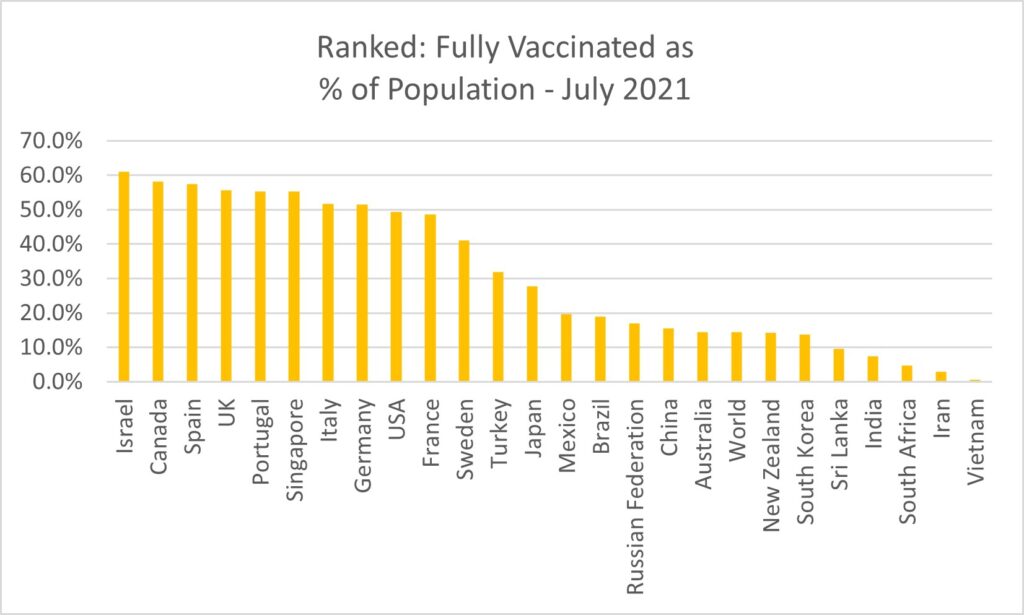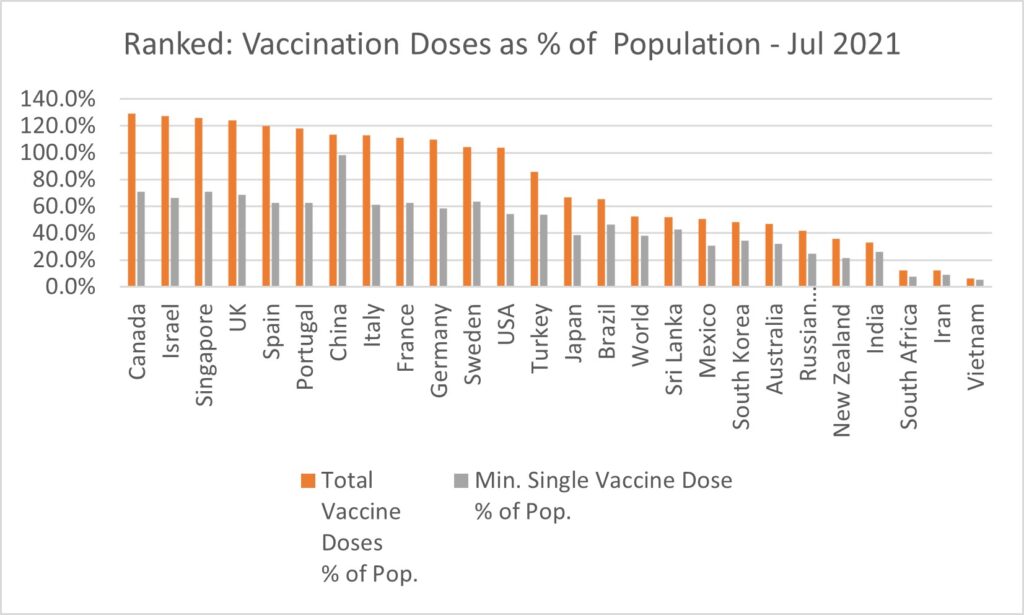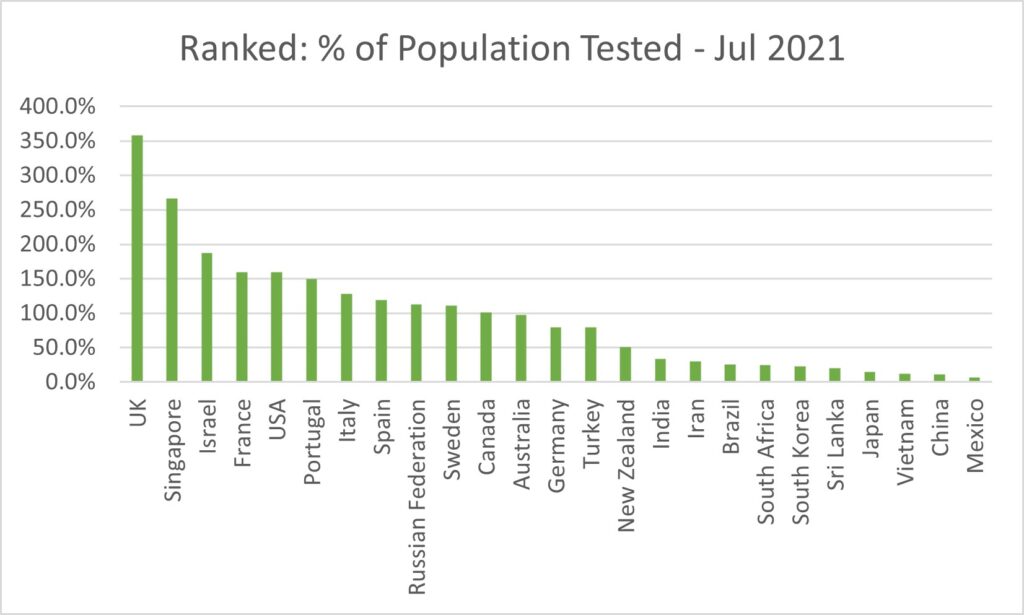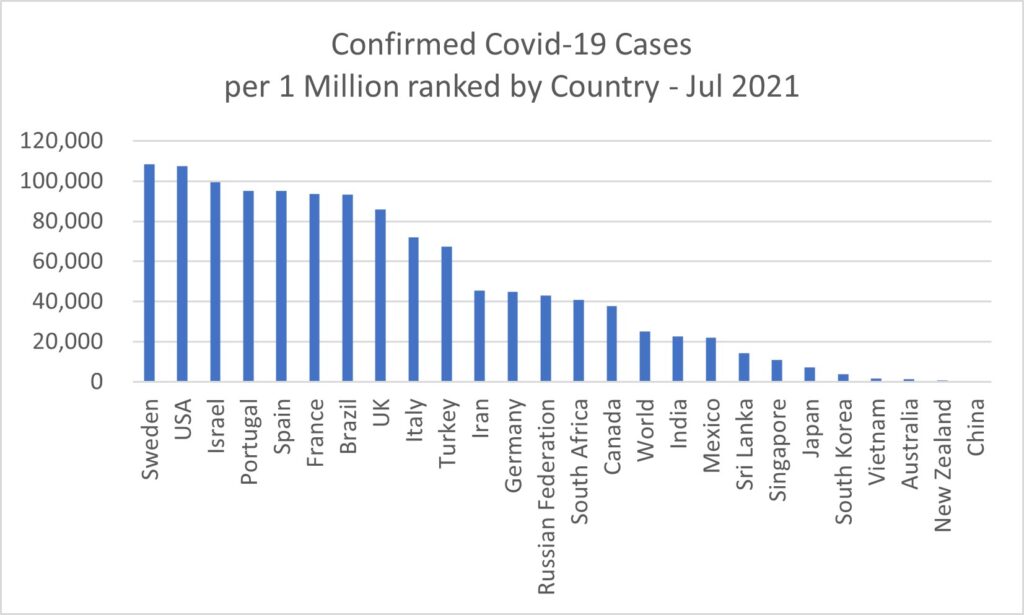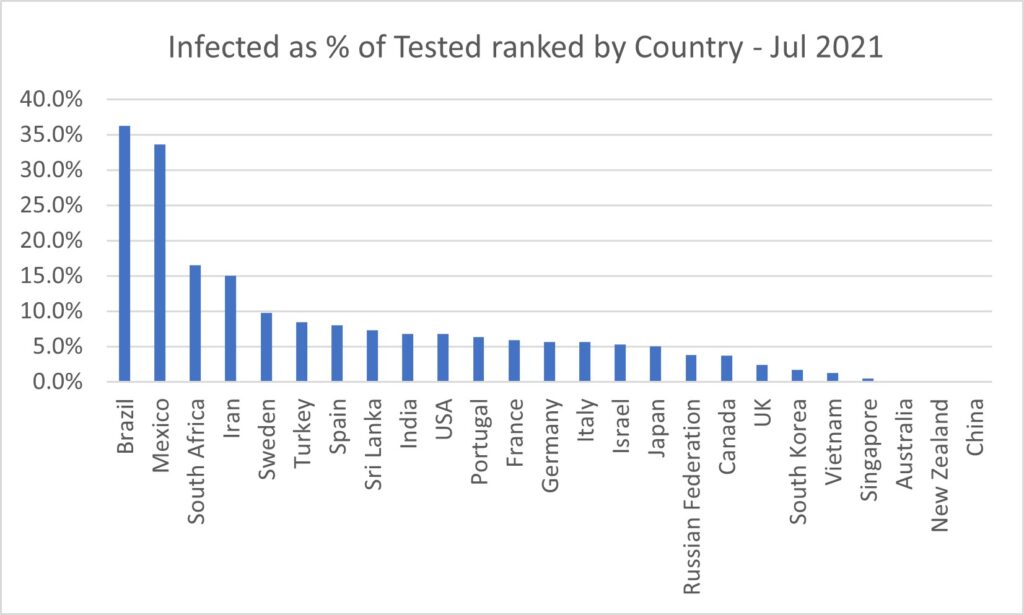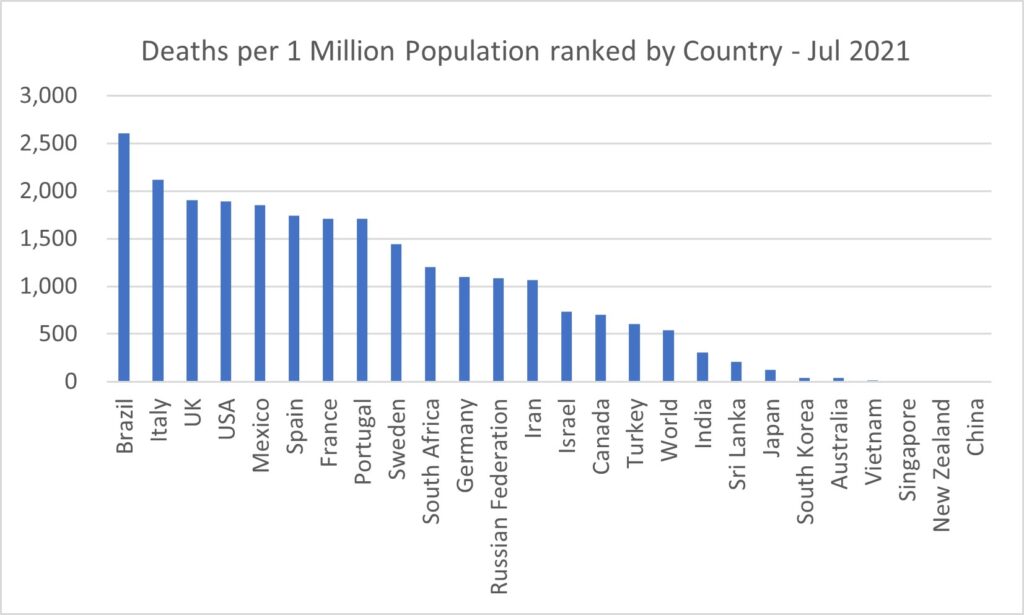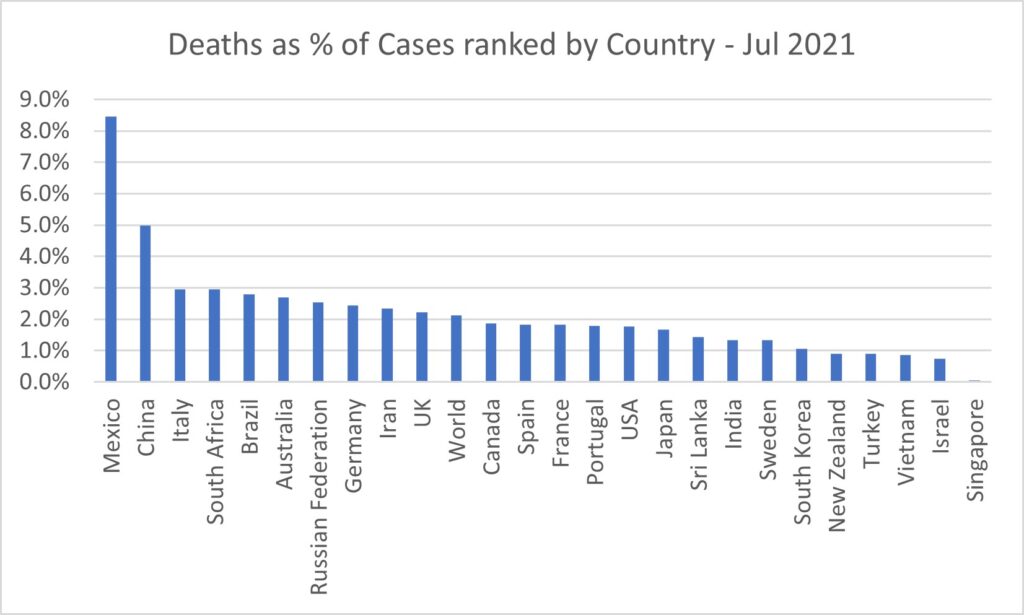
Compilation of global statistics for Covid-19 infections and testing from multiple verified sources with related stats for population demography, health risk factors, health care infrastructure and some key economic indicators. These stats are for a selected diverse list of 23 countries (spanning geography, population demography, health risk factors, economic development and health infrastructure) to facilitate global comparative analysis and identification of potential influences / drivers.
The analysis of this data reveals some interesting risk factors and relationships. The stats were updated on regular basis to generate time series data for trend and other potential predictive analytics.
For this study the following factors were considered as strengths or weaknesses internal to a country:
Population Demography :
- Percentage of Population 65 years or older
- Median Age of population
- Urban Population (as a percentage of total
- Literacy rate
Population Health Risk Factors :
- Life Expectancy at birth
- Adult prevalence of Obesity (as a percentage)
- Major Infectious Disease Risk assessment (only available for limited countries)
Health Infrastructure :
- Physician Density per 1,000
- Hospital Bed Density per 1,000
- Healthcare expenses as a percentage of GDP
Economic Strength and Financial /Technology Resources :
- Gross Domestic Product (GDP) on Purchasing Power Parity (PPP) measurement basis
- Per Capita PPP GDP
For this study the following factors are considered as opportunities or threats/risks that are external to a country:
Covid 19 Source Data
- Number of Covid 19 Tests
- Number of Confirmed Covid-19 Cases
- Covid 19 related Deaths
- Covid 19 patients who have Recovered and Discharged
- Covid 19 Active Cases
- Active Cases reported as Mild Condition
- Active Cases reported as in Serious or Critical Condition
Covid 19 Analytic Data / Key Performance Indicators (KPIs)
- Percentage of Global Confirmed Cases – as reported by countries as infected with Covid 19
- Percentage of (Country) Population Infected with Covid 19
- Infected as a Percentage of Tested
- Percentage of Population Tested
- Tested as a Multiplier of Confirmed Cases
- Recovered / Discharged as Percentage of Confirmed Cases
- Recovered / Discharged as Percentage of Closed Cases
- Deaths as Percentage of Confirmed Cases
- Deaths as Percentage of Closed Cases
- Mild Condition as Percentage of Confirmed Cases
- Mild Condition as Percentage of Active Cases
- Serious / Critical Condition as Percentage of Confirmed Cases
- Serious / Critical as Percentage of Active Cases
The below comparative analysis is based on a compilation of global statistics for Covid-19 vaccinations, testing, infections and deaths from multiple verified sources with related data for population demography, health risk factors, health care infrastructure and some key economic indicators.
These statistics are for a selected diverse list of twenty-five countries, spanning geography, population demography, health risk factors, economic development and health infrastructure, to facilitate the global comparative analysis and identification of potential influences / drivers.
The twenty-five countries chosen for the analysis include: USA, India, China, UK, Canada, Brazil, Russian Federation, France, Spain, Mexico, South Africa, Italy, Iran, Germany, Turkey, Israel, Portugal, Sweden, Japan, Singapore, Australia, South Korea, Sri Lanka, New Zealand, and Vietnam.
Israel and Canada ranked at the top with 61% and 58% of their population fully vaccinated (with two doses) as at end of July 2021. Spain, UK, Portugal, Singapore, Italy and Germany were also able to fully vaccinate over 50% of their populations achieving a key milestone.
However, in terms of total number of vaccinations administered China (1.64 Billion), India (462 Million), and USA (and 345 Million) topped the list globally. During the month of July China administered an average of 13.2 Million doses per day while India came in second at about 4.35 Million doses per day. In comparison USA administered an average of 645,000 doses per day in July.
Canada topped the list with total vaccination doses administered at 129% of the population, Israel coming in second at 127%. Singapore (126%), UK (124%), and Spain (120%) were the next top performers.
Minimum single dose of vaccinations as a % of the population were topped by Canada and Singapore at about 71% with UK (68.5%) and Israel (66%).
The UK and Singapore topped the extent and coverage of Covid-19 testing with about 3.6 times and 2.7 times the population tested, followed by Israel (1.9 times), with France and USA (1.6 times).
As for volume of testing, USA tops the list at about 530 Million tests at the end of July, followed by India at 466.5 Million tests. UK has conducted 244 Million tests, Russian Federation 165 Million tests, and China 160 Million tests. Interestingly China stopped reporting further Covid-19 testing numbers around the third quarter in 2020 with the cumulative testing numbers remaining flat at 160 Million.
India topped the list in terms of the average testing rate per day in July at 1.8 Million tests/day, with UK coming in at around 1.0 Million tests/day, punching above its weight when compared to overall population size. USA did an average of 765,000 tests/day with the Russian Federation averaging 506,000 tests/day in July. It should be noted that although India topped the list for average daily testing at 1.8 Million per day it should ideally be averaging around 5.0 Million tests per day given the scale of Indian population size currently estimated at very close to 1.4 Billion.
Confirmed Covid-19 Cases per 1 Million population is highest for Sweden (108,000) and USA (107,000) followed by Israel (99,000). Whereas China (64), New Zealand (586), Australia (1,338), Vietnam (1,530), and South Korea (3,900) have performed significantly better at containing the Covid-19 infections among its population based on the ‘officially’ reported statistics. It should be noted that the extent and depth of coverage for Covid-19 population testing will influence this Key Performance Indicator (KPI).
Covid-19 Infection Rate as a percentage of number of Tests is another excellent metric and key performance indicator (KPI) for gauging the rate of infection spread among the population. It should be noted that this is a ‘cumulative’ KPI to 31 July 2021 since inception. As per the chart below Brazil and Mexico have the highest Covid-19 infection rate at 36% and 34% respectively, followed by South Africa (16.5%) and Iran (15%). Whereas China, New Zealand and Australia have some of the lowest infection rate of 0.1%, followed by Singapore (0.4%), Vietnam (1.3%) and South Korea (1.7%). UK (2.4%), Canada (3.7%) and the Russian Federation (3.8%) are also on lower end of the infection rate, with USA (6.7%) and India (6.8%) in the mid-range although the later two countries have the highest total number of confirmed Covid-19 cases globally. Another way to look at this, in USA and India about 1 in every 15 people tested for Covid-19 were confirmed as infected.
In terms of highest ‘cumulative’ number of confirmed Covid-19 cases, USA officially reported 35.7 Million as at end of July, with India reporting 31.7 Million and Brazil 19.9 Million cases.
Confirmed Covid-19 related Deaths per 1 Million population is highest for Brazil (2,600) and Italy (2,120) followed by UK (1,900), USA (1,890) and Mexico (1,850). Whereas China (3), New Zealand (5), Singapore (6), Vietnam (13), Australia (36) and South Korea (41) have performed significantly better at containing the Covid-19 deaths among its population based on the ‘officially’ reported statistics. This correlates with the correspondingly lower Confirmed Covid-19 Cases per 1 Million population for these countries (please refer previous chart for comparison). Canada (700) and Israel (736) were around the mid-point with India officially reporting only 305 deaths for 1 Million.
Covid-19 related Deaths as a percentage of confirmed Cases is another excellent metric and key performance indicator (KPI) for gauging the death rate among the infected population. It should be noted that this is a ‘cumulative’ KPI to 31 July 2021 since inception. As per the chart below Mexico and China have the highest Covid-19 death rate at 8.5% and 5% respectively, followed by Italy and South Africa (2.9%), Brazil (2.8%) and Australia (2.7%). China’s high death rate may be due to most deaths being reported in the initial stages of the pandemic in 2020 when the treatment protocols were not yet well established. Whereas Singapore reported the lowest death rate of 0.1%, followed by Israel (0.7%), Vietnam, Turkey and New Zealand (0.9%). UK (2.2%), Canada (1.9%) and USA (1.8%) are on the mid-range of the death rate. India reported a lower 1.3% death rate although it reported the third highest total number of confirmed Covid-19 deaths globally at the end of July 2021.
The highest ‘cumulative’ number of confirmed Covid-19 deaths officially reported were about 629,000 deaths for USA, 556,000 deaths for Brazil, and 424,000 deaths for India as at the end of July 2021.
A SWOT methodology driven global comparative analysis for Covid 19 can be useful for:
- Identifying strategic direction and plans that will likely be most effective based on global benchmarking and current performance.
- Help identify potential impediments and constraints that will limit success and ability to achieve goals and objectives.
- Reveal possibilities, likelihood and limitations to effecting positive change.
- Facilitate identifying and exploring new solutions to existing challenges.
- Act as a tool to facilitate brainstorming ideas and a recording and documentation for communication across multiple disciplines and stakeholders.
- Supporting and enhancing the credibility of data interpretation, analysis and conclusion of this report and presentation to peers, interested parties and other stakeholders.
The above is the preliminary raw data analytics. Analytical observations and conclusions to follow. However, to a great extent the Covid 19 Key Performance Indicators (KPIs) defined above speak for themselves, when used in conjunction with comparison data for other countries for benchmarking and performance analysis.
Correlation of KPI performance to country specific individual strengths and weaknesses requires further work including statistical, regression and/or other pattern recognition analytics. Further extension of this work will be development of country specific prediction and forecasting models for Covid-19 to support healthcare planning and intervention.
Appendix




